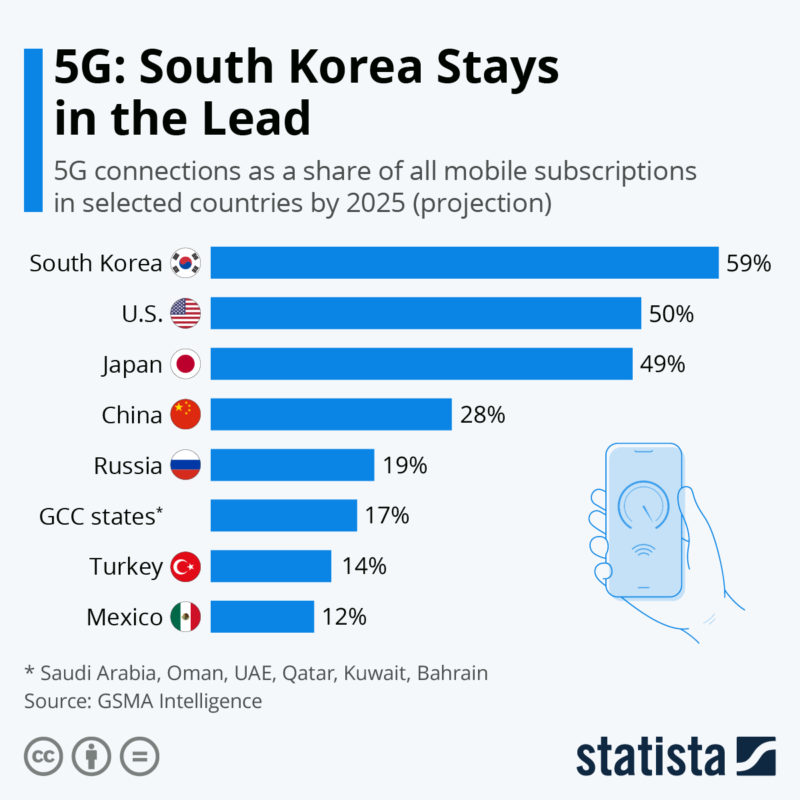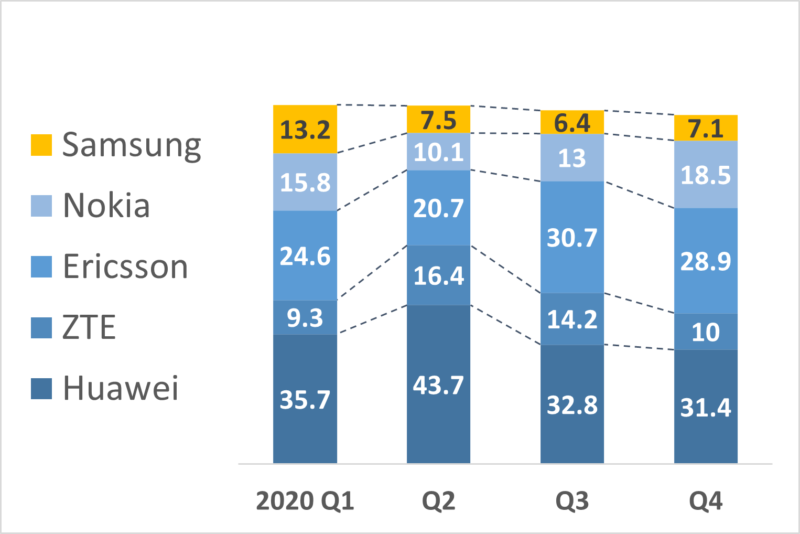5G and South Korea: From Fast Mover to True Innovator?


As South Korea is one of the front runners when it comes to 5G technology implementation, we are going to dive into some of the key insights of the 5G roadmap in the region. More, you will get a primer on the topic of 5G and how does it impact GNSS positioning.
South Korea has been a fast mover on 5G since it arguably won the crown of the world’s first country to commercialise the 5G network on 3 April 2019. Today, the country boasts high marks on every indicator, including 5G download speed, availability, and coverage. A report released in June by Opensignal notes that South Korea’s 5G networks, provided by three telecommunications companies – SK Telecom, KT, and LG U+, demonstrated impressive results: download speeds at 327-399 Mbps, 25-27% availability, 82 points out of 100 for 5G video experience on average, 90 for 5G games experience, and 85 for voice app experience.
 |
More recent figures by South Korea’s Ministry of Science & ICT show average download speeds roughly stand at 808 Mbps with SK Telecom being fastest at 923.2 Mbps. The difference in figures may reflect the status of 5G availability as users have to resort to 4G networks when not connected to 5G stations. The Opensignal report said the proportion of time users are connected to 5G network is between 25-27% on average in South Korea. When it comes to 5G adoption, 16.5 million users in South Korea, about 23% of the population, have already switched to 5G. GSMA Intelligence predicts that 59% of mobile phones will operate on 5G by 2025 in the country, ahead of other countries – 47% in China and 55% in the US. (See Fig 1)
All these numbers are brilliant, given stark contrasts with those in other countries. 5G download speeds average about 75Mbps, and the high-speed 5G covers less than 5% of its geographic area in the United States. |
| Figure 1. Source: Statista (Chart: 5G: South Korea Stays in the Lead | Statista) |
But what are the impressive numbers supposed to mean? To gauge South Korea’s true competitiveness on 5G, we need to dig a little deeper. |
What is 5G?
Officially known as International Mobile Telecommunications 2020 (IMT-2020), 5G is the fifth generation of cellular networks developed to greatly increase speed and reduce delays with the requirements below.
- High-bandwidth and faster connectivity speed (eMBB: enhanced Mobile Broadband)
- Immediate responsiveness (URLLC: Ultra Reliable & Low Latency Communication)
- The extremely high density of online devices (mMTC: massive Machine-Type Communication).
The full 5G network can transmit data at a peak speed of 20Gbps, up to 20 times faster than the existing 4G LTE, and offer latency of 1 millisecond, making real-time control or feedback possible.
5G means a lot more than a high-speed internet connection with which users can download large video files in the blink of an eye. Together, the features above will revolutionise the way we live by spurring countless new applications that require ultra-fast data transmission, high reliability, and faster response time. Such applications that have previously been impossible may include autonomous driving, life-saving applications, flexible logistics solutions, more realistic VR and AR to name a few. Whilst 5G expands consumer experiences and transforms business operations, at a state-level, building solid infrastructure will be an essential job for governments to attract investment and achieve economic growth.
In this regard, South Korea is getting ahead in strong infrastructure —network quality, coverage, and user base. But would that be enough for the country to stay in the lead on 5G?
What’s the impact of 5G on GNSS positioning?
The fifth generation of mobile connectivity has first an impact on the speed through which the positioning data can be transmitted and accessed. A major use case for GNSS and 5G synergies are emergency applications where it can make the difference between life and death. For example, if a car has an accident the location of that car and other location parameters can be transferred more quickly through the 5G infrastructure. Therefore, the time of response is considerably faster. Thus, the safety of passengers can be significantly increased due to 5G connectivity.
Currently, various actors are experimenting with different synergies between 5G & GNSS. Because 5G can also be used as a network-based positioning system. The previous standards were limited by a 50 meters accuracy, however, with a combination of 5G and GNSS, an accuracy below 1 meter can be achieved. These new developments can have a direct influence on multiple applications such as industrial IoT (or smart manufacturing), autonomous driving, timing synchronisation and drone delivery. South Korea has high ambitions for autonomous driving and is pushing for satellite navigation and terrestrial connectivity infrastructure.
Read about South Korea’s ambition to be a leader in autonomous driving technologies.
When it comes to indoor positioning, GNSS and 5G are perfect companions. The hybrid positioning approach based on GNSS and 5G can perform better than using the technologies as standalone services. Thus, 5G can provide novel approaches for sub-meter accuracy in indoor and urban areas where GNSS is not available or doesn’t offer sufficient accuracy for tracking mobile devices. This offers countless possibilities in the application of indoor robots or smart manufacturing.
Read about South Korea’s ambition to build their own satellite navigation infrastructure (SBAS)
Challenges Loom Large
In addition to infrastructure, 5G quality depends on services, products, and the business environment. South Korea has been making a lot of efforts to improve all of them. Telecom companies are actively cultivating service areas: LG U+ eyeing on entertainment content, SK Telecom joining a 5G smart factory alliance, and KT Corporation focusing on R&D and diverse subscription plans. KT also introduced South Korea’s first 5G standalone (SA) network in July 2021. The government, on the other hand, has provided critical support at the initial stage of 5G progress. It laid out the 5G Plus Strategy in April 2019 along with 5G commercialisation while offering tax incentives and subsidies to expand 5G networks swiftly.
Despite visible progress, however, intensifying global competition is revealing weak spots in South Korea’s 5G system and strategy. JoongAng Ilbo, a Korean daily newspaper, uploaded a series of articles in May this year to examine challenges posed to the country’s global 5G power status. The pieces and other sources pointed out a few worrying trends on 5G in South Korea.
Above all, South Korean 5G equipment is losing its market presence. Samsung Electronics is the only major Korean equipment supplier, but its global share had declined from 13.2% to 7.1% in 2020 alone. Samsung is also the world’s number-one mobile phone manufacturer, yet to take 5G models alone, it is ranked 4th with only 12.7% of the global market share.
|
Also, software industries and content platforms are weak at best. Domestic companies hardly reap the benefits of strong 5G networks as they cannot provide attractive consumer services. Global sensations like TikTok or Roblox reminds us that domestic players have a long way to go in a 5G environment. 5G’s value lies not only in high speed and responsiveness but also in its synergy with auxiliary industries ranging from self-driving to drones to IoT. Those related industries are not as competitive as desired, however. Hyundai Motor Company, for instance, conducts self-driving tests mostly through its US branch as they prefer industrial partners with the required expertise. Rigid and outdated regulations are another reason that holds back future technology development within Korea. |
 Fig. 2 |
Read about South Korea’s desire for becoming an urban mobility leader. GNSS.asia provides insights into the South Korean Urban Air Mobility (K-UAM) roadmap.
Future
Faced with challenges from inside and outside, key actors in South Korea are aware that, for 5G to get ahead, it will need to create synergies with technologies like AI, big data, and IoT. The government has recently announced it would foster 1,800 companies specialised in 5G services in the next five years. Telecommunications companies, realising the limitations of the B2C profit model – e.g., video content, are tapping more B2B opportunities in robotics and other emerging technologies. Meanwhile, Samsung unveiled new chipsets optimised for 5G stations. Once put together, current efforts to overcome shortcomings and thrive in the 5G market will stimulate innovation even further.
You are a company that could support 5G infrastructure development in South Korea? Drop the GNSS.asia Project Manager South Korea, In-Seung Kay, a message at kay@gnss.asia